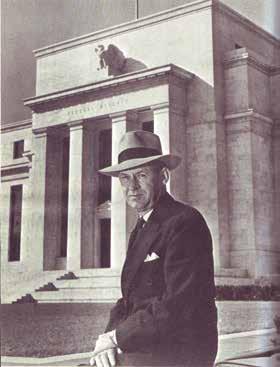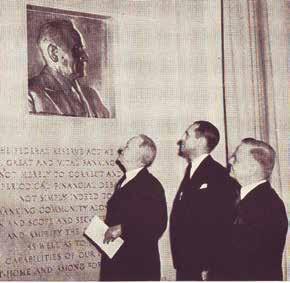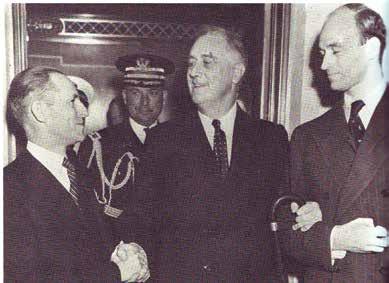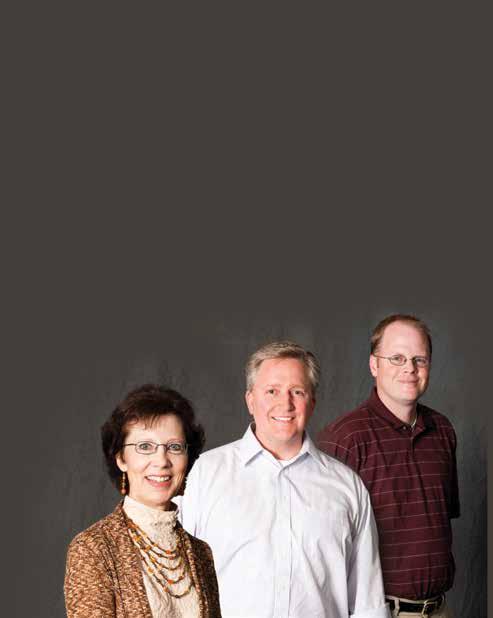
9 minute read
ACADEMIC NEWS
Legacy
By CHRIS RIGBy ARRINGTON
Marriner eccles, economic innovator after the great Depression
Born and raised in Logan, Eccles Ran First Security Bank, Until President Franklin Roosevelt Named Him Chairman of the Federal Reserve Bank in 1934

Marriner leaving the Federal Reserve Building for the last time, 1951. The building was later named for him.
Marriner Eccles in Scottish kilts at around five years old. Plaque in the front lobby of Federal Reserve Board Building. Carter Glass, Marriner S. Eccles, Henry Steagall Marriner (left) greeting Franklin D. Roosevelt and his son James upon arrival at the New Federal Reserve Building for the dedication ceremonies, 1937.
Marriner, on mission for the Church of Jesus Christ of Latter-day Saints in Scotland, 1910.
Eldest Son
It’s all about his epiphany— an epiphany that didn’t come until he was 41 years old, and that resulted in his helping to reshape the postDepression world.
The subsequent generosity of generations of the Eccles family to USU makes that family’s history a crucial part of USU’s legacy. This is evidenced by the George S. Eccles Business Building (named for Marriner’s brother), and by the Eccles name on a host of USU buildings and programs— from the nationally ranked Emma Eccles Jones College of Education and Human Services, to the Caine College of the Arts named for the family of Marie Eccles Caine, the Eccles Science Learning Center, and many more.
Marriner Eccles was born in Logan in 1890, the eldest of nine children of David Eccles and his second wife, Ellen Stoddard Eccles. If you drive down Center Street in Logan to 250 West Center, you can see the beautiful stone mansion that David Eccles built for Ellen in 1907, when Marriner was just 17 years old. Marriner left from that house two years later for an LDS mission to Scotland, having completed three years of high school in Logan. That was the sum total of his formal education.
David Eccles had been born into poverty in Glasgow, Scotland, in 1849. David’s family joined the LDS Church and emigrated to Utah in 1863, funded by the Perpetual Emigration Fund. A gifted and hard-working entrepreneur, David Eccles founded 54 separate enterprises in the American West, including several banks, the Oregon Lumber Company, and the world’s largest mining and construction firm, the Utah Construction Company— one of a consortium of five builders of the gigantic Hoover Dam.
When David Eccles died unexpectedly in 1912 at age 63, his estate was valued at some $7 million. Marriner, by then age 22, ultimately came to run much of his father’s business empire, together with George, his brother. George had attended Utah State, had finished college at the University of California, and had completed a graduate degree from the Columbia University School of Business. Several of the family’s younger siblings also went to Utah State, including Spencer, Marie, and Willard.
Marriner and George Eccles then led the creation of what is considered the first multibank holding company in the U.S., with banks in 17 locations in Utah, Idaho, and Wyoming, in order to conduct interstate banking. They were joined in the business by brothers Spencer and Willard. Spence’s son and namesake, Spencer F. Eccles, became chairman and CEO of First Security in 1982, later merging it with the Wells Fargo Corporation in 2000.
Spencer F. Eccles is now chairman emeritus of Wells Fargo’s Intermountain Banking Region and also chairman and CEO of the George S. and Dolores Doré Eccles Foundation. He said of his famous uncles Marriner and George, “I worked for both Marriner and George for my whole First Security career up until their passing. I personally consider both of these leaders to be heroes, each in his own right. Marriner is considered to be the father of the modern Federal Reserve Bank, having restored its independence, back from New York City to the Washington Fed.”
Marriner’s Economic Innovations
Marriner had learned from his father that “progress comes only through toil, economy, and thrift, and that these alone are the motive power which creates the enduring structure.” (Marriner Eccles, 1925)
But then he experienced the Great Depression.
When the Crash of 1929 occurred, Marriner Eccles was president of seven companies: the Eccles Investment Company, First Security Corporation, First National Bank of Ogden, First Savings Bank of Ogden, Eccles Hotel Company, Sego Milk Products Company, and the Stoddard Lumber Company. He was vice-president/treasurer of Amalgamated Sugar, and a director of more than six companies, including Utah Construction Company, UtahIdaho Central Railroad, Utah Power and Light, and Mountain States Implement.
by photo , 1976.
hyman sidney ”,
servant public and entrepreneur private ,
eccles marriner , 1951; “
eccles .
s marriner ”,
recollections personal and public ,
frontiers beckoning “
books the by from photo photos
Marriner successfully staved off potentially disastrous runs on his big Ogden banks with quick thinking and nerves of steel. He wrote in his autobiography “Beckoning Frontiers,” “No depositor lost one penny.” On the first day of the 1931 bank panic, he instructed his tellers to process every request slowly, requiring each signature and counting out bills and coins methodically. He had an armored truck deliver boxes, and he announced, “There’s plenty of money for everyone,” though only a few of the boxes contained money he could hand out. He kept the bank open late, serving every single customer.
He experienced great sorrow and frustration during the Depression years, until he had a powerful realization in 1931, “The inherent instability of capitalism may be corrected by conscious and deliberate use of three compensatory instruments, taxation, varying government expenditures, and monetary control.” (Marriner Eccles, 1935)
He further declared, “The government must be looked upon as a compensatory agency in this economy to do just the opposite of what private business and individuals do. The latter are necessarily motivated by the desire for profit. The former must be motivated by social obligation.” (Marriner Eccles, 1936)
Both Franklin Roosevelt and Herbert Hoover ran for President in 1932 on platforms of balancing the budget. In February 1933, Marriner Eccles was invited with 45 other prominent Americans to address the Senate Finance Committee on causes of and cures for the Depression. Eccles said that, under the circumstances—the Great Depression, in which unemployment reached 25%—balancing the budget was exactly the wrong thing to do. He laid out a fivepoint program of government spending that would put money in the hands of people who would spend it immediately, versus corporations that faced very low demand for their products at that time and thus were unlikely to spend more. The program included unemployment relief and public works projects.
He also proposed a plan, as described by Huntsman School of Business Professor L. Dwight Israelsen, “for long-run economic stability that included,” among other points, “unification of the banking system under the Federal Reserve” and “creation of an agency to guarantee bank deposits (FDIC).” These are both keystones of the financial system that we have today. (L. Dwight Israelsen, “Marriner S. Eccles, Chairman of the Federal Reserve,” American Economic Review 75, May 1985: 357-62.)
Franklin Roosevelt named Marriner Eccles Chairman of the Federal Reserve in 1934, a position Marriner held until 1948, then serving on the Fed’s Board of Governors until 1951. He was credited with championing the Fed’s independence, from the New York Fed, from the Department of the Treasury, and from politics. Dr. Israelsen said that Marriner’s work during these years made him “the father of modern macroeconomic stabilization policy.”
In 1946—after World War II—Marriner helped craft agreements that created the World Bank and International Monetary Fund. He supported the Marshall Plan for European Reconstruction in 19489, and served on the Export-Import Bank’s Advisory Board. Finally, he was very active in philanthropy, funding numerous charitable, scientific, and educational organizations.
Marriner died in Salt Lake in 1977, at age 87. Five years later, the Federal Reserve Board Building in Washington, D.C., was named in his honor.
On the 40th anniversary of the dedication of the George S. Eccles Business Building—May 8, 2010— Spencer F. Eccles gave the convocation address for the Huntsman School. Dean Douglas D. Anderson said on that occasion that the generous contributions of the Eccles family foundations made them “the bridge—the indispensable bridge—from our pioneer poverty to our future prosperity. Each one of us . . . owes a great deal to the vision and generosity of multiple generations of the Eccles Foundation and their family.”


a R e taking flig Ht t HRoug H
in Huntsman school courses, programs, and clubs, in the entrepreneurship center and the Huntsman alumni community, the winds of innovation are rising.
By CHRISTINE ARRINGTON

Maybe it’s something in the water. Or in the famous dairy products. Aggie ice cream anyone?
Or in the DNA. Some professors at Columbia University are doing research on whether or not the great migration from Europe to America selected a particular population of people who were significantly more risk oriented—genetically!—than those who chose not to come.
And a tolerance for risk is an important part of innovation.
The fact is that year after year more new businesses are started in Utah than in almost any other state, and many of those businesses are built on substantial, creative innovation. Call it a gift from the pioneer heritage or a result of the inveterate optimism of the West, innovation is alive and well in the Huntsman School of Business and its alumni community.
In recognition of the economic resilience of Utah State’s hometown, Time Magazine christened Logan one of 10 “Boomtown USA” cities, in its April 2, 2012, issue. Under the heading, “A look at growing cities and what’s fueling their growth,” Logan was shown with just 3.9% unemployment on a “Boomtown” map of the U.S., at a time when the national rate was 8.3%. Why? “Roughly 1 in 5 employees works in manufacturing, much of it food-focused. Pepperidge Farm, for example, is expanding Goldfish-cracker production at an area plant.”
Have you heard that theme somewhere else recently? The needed resurgence of U.S. manufacturing?
Utah State University, of course, has a strong legacy of innovation, particularly in its Space Dynamics Lab, in engineering, and in agriculture. Its Commercial Enterprises program launched in January 2012 is described as “the one stop shop for intellectual property protection and business development.”
Add to this the business innovations that have come from graduates of the Huntsman School of Business—innovations that may be less well known, in some cases—and an even stronger picture emerges of how this culture, this kind of education, and these values have produced significant innovation and development for the better.
From utah State to Korea
Young-Chul Hong from Korea, for example, earned an MBA at Utah State in 1973. He returned to the specialty steel business his father had started, Kiswire Trading, becoming president and CEO in 1988. He oversaw the opening of new factories and the diversification of the company’s product line. Today the company has $2 billion in revenue, a 10% global market share, and 4,600 employees in 19 production facilities, in Korea, China, Malaysia, and the U.S.
Young-Chul decided recently that even more innovation was needed. The company has opened a pioneering factory catering to homemakers’ schedules, and it has another socially inventive factory designed to be run by skilled retirees who told the management team that they didn’t want to retire yet.
Kiswire also is deeply involved in developing state-of-the-art superconductive wire. The Foster Business magazine reported this past spring that Kiswire’s superconducting coils are to be “a key part of Korea’s contribution to the International Thermal
by photo frisby photo by design by hilary


